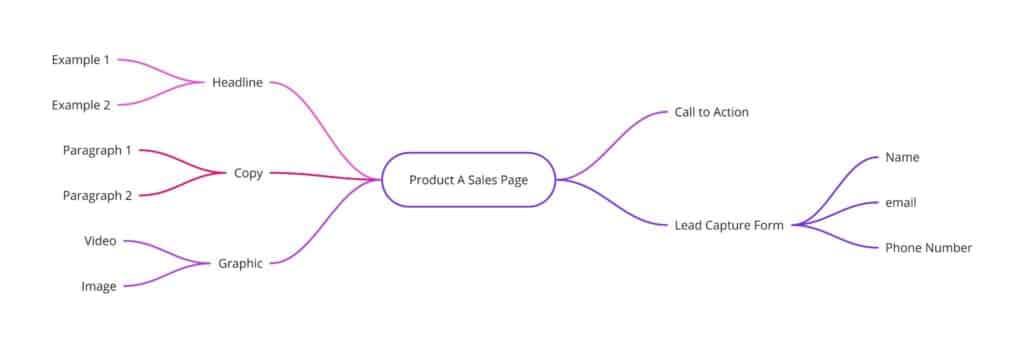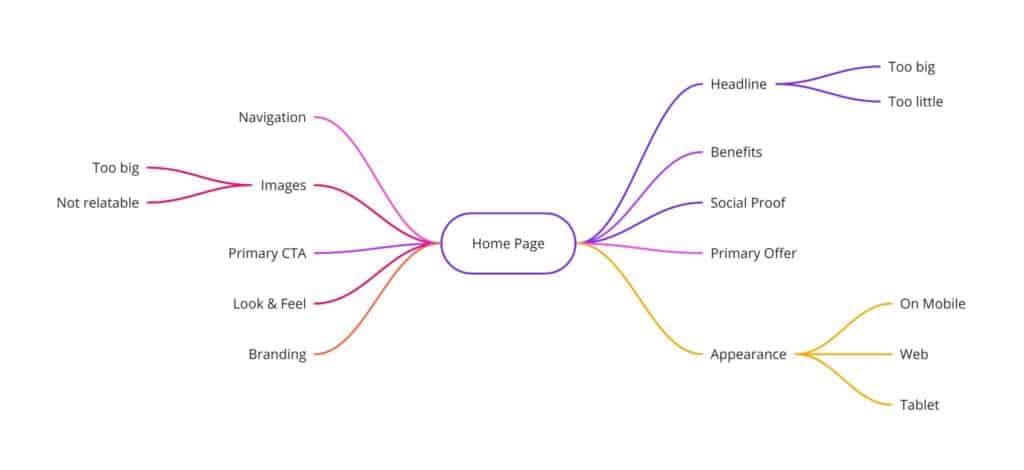Have you ever had one of those moments when your mind is racing over a project and won’t let you sleep? Mind mapping is a visual tool that will not only help you stop that racing mind, but help you both express your ideas to your project team and gather ideas from them!
What Is Mind Mapping?
In a nutshell, mind mapping is a brainstorming technique designed to document, share, and streamline of all your unfiltered, unorganized thoughts while also building relationships between those different thoughts. It can be used individually or by teams.
Simplistically, it is a diagram that kind of looks like a tree:

To create this, I used Miro’s Mind Mapping template.
At the center is the central topic: the concept, problem, or idea to be discussed. Branches and nodes extend from that central concept or trunk to form subtopics. From each branch are subsequent branches which build on the previous branch to communicate finer and finer details in a hierarchical structure.
For example, this could be what the start of a mind map for a problem or idea looks like:

Your diagram can then become more complex as your ideas develop, such as in the example below:

A Brief History Of Mind Mapping
While it's been around since the time of Aristotle—it was used by Porphyry of Tyre in the 3rd century to map out categories of Aristotle—it was more recently popularized in the 1970s, and remains a great tool in the facilitator's toolkit for visual and creative thinking.
What we think of today as a mind map—a radial network of nodes and branches—was popularized in 1974 by Tony Buzan, a British popular psychologist.
The Purpose Of Mind Mapping
In our digital project management world, mind mapping is a great tool or technique to map out ideas and relationships, particularly related to developing requirements with clients in brainstorming activities and problem-solving.
The goal is to build a visual representation of the discussion and the associated relationships around the central theme (the problem or idea). Visual models such as mind maps really help teams collaborate effectively together in a meeting, and these models are much better at capturing relationships between ideas than simple text in a document.
Learn more about the purpose of mind mapping here.
Benefits Of Mind Mapping
Mind mapping has a wealth of psychological benefits that will ultimately improve productivity on your projects. Here are 8 of them:
- More effective problem solving: Mind mapping allows you to see problems from all angles and integrate both left and right brain thinking.
- Increased productivity: Everyone can put their heads together and come up with quick and creative solutions, and then use mind maps to break them down into manageable tasks or chunks.
- Improved communication: Mind maps help you organize your ideas so you can then communicate them more effectively to team members and stakeholders.
- Better recall and understanding: With your thoughts and ideas organized, you can improve your memory retention and overall comprehension for each piece of information.
- Enhanced learning and creativity: Studies have shown mind mapping increases learning outcomes and creative thinking.
- Simplify complex ideas: Mind maps allow you to see both the big picture and how the details fit together.
- Improved presentations: Mind maps are a great visual for your audience, and they help organize and structure presentations in a way that's easy for the audience to follow.
- Better critical thinking skills: Studies have shown that mind maps improve critical thinking and help users generate creative solutions and evaluate those solutions for better decision-making.
Read more about the benefits of mind mapping here, along with more supporting studies and data.
Mind Mapping Examples
Let's go through three case studies to better understand when and how to use mind mapping.
- Brainstorming: a great way to flesh out vague requirements into more meaningful details
- Problem solving: a great way to work out what the root cause of the problem is and better scope the problem
- Visual thinking: a great way to get those ideas out of your head and into a structure so you can explain them to someone else
Brainstorming
A scenario I’ve run into multiple times, particularly in projects that involve designing and building digital assets, is one where we need to design a particular page with very vague requirements from the client. Let's say it's a sales page.
We know that key elements of a sales page are:
- Headline
- Copy
- Interesting graphic or video
- Call to Action
- Lead Capture Form
What you would do with the mind map is: put the type of sales page in the center of the map, with five branches—one for each of the above key elements. You would start with something that looks like this:

Then have the team—possibly with the client—build out further branches off of the 5 core branches to create the associated content for each one. You may want to even have alternative options within the main branches that can then be evaluated or selected from.
Problem Solving
In our second scenario, problem solving, an example that readily comes to mind is presenting a web page to a client and then having them decide it doesn’t work.
The problem is that they haven’t given you specific feedback that is helpful in the redesign. What you’ll need to do is understand what the problem with the page really is.
To use a mind map in this scenario, start out with some of the standard elements of the page; things like the headline, navigation, etc. Then you’ll want to have the input from the team on what additional branches of the issue could be—softer or less specific elements such as look and feel, or more specific sub-branches, such as the headline being too big or too little.
These may not always be specific enough to know what to do (at least without confirmation from the client) but it will help paint a picture of where the issues are. This would result in a mind map that could look like:

From there, your team can select which elements to work on to redraft the page.
Visual Thinking
I find this to be a great tool to ‘unravel’ an idea that is noodling around in my head—so this example is about working through something independently. Mind maps can be a great way to help you get a good night's sleep. Draw the trunk and a couple of branches out and go back to bed!
One example that might wake you up or make it hard to go to sleep: finding a new project management job! Here’s what it could look like:

Tips For Getting Started With Mind Mapping
- Start with the central or main idea. This is the ‘trunk’ of the mind map. Pick a couple of keywords—one noun and one verb are sufficient to describe the central idea. Don’t forget you’re building a tree that will have multiple limbs and branches. Don’t make this complicated.
- Have each person (if you’re working with your team) add a related idea to that central trunk. Ensure you get one new idea per person, to make sure everyone participates and is heard in the brainstorming session.
- Avoid using mind maps with groups larger than 6 people. Make sure you have the right people in the room helping you build your mind map!
- Have the group work individually or in small groups on building a specific sub-branch of the mind map. This will make sure the tree is not unwieldy and overly complicated. Each of these sub-branches should directly relate to the ‘branch’ before it.
Mistakes To Avoid When Creating Mind Maps
Here are five common mistakes to watch out for as you're creating your mind maps.
- Don't make the central idea or main idea too specific. You won't have anywhere to go. As mentioned, keep it to one or two keywords.
- Don't use a surface that's too small. You don't want to run out of room on your whiteboard or sheet of paper. Software is great here because it often provides infinite space.
- Don't include too many people. As mentioned, limit your sessions to 6 people or less, and make sure you have the right people. Your project sponsor probably doesn't need to weigh in on the design issue you're running up against.
- Don't limit yourself to text. Add images, illustrations, diagrams, and whatever else you need to make your point. Most mind mapping software offers this capability as well.
- Don't forget to set a clear purpose for the session. Are you solution-ing or simply brainstorming? Make sure your participants are clear on the desired outcome of the session.
Recommended Tools for Efficient Mind Mapping
While hand-drawn mind maps can be extremely helpful, mind mapping software allows you to create and customize mind maps online, and often collaboratively. Luckily, there is a large market for mind mapping tools, so you will have plenty of opportunities to find the best tool for you. There are even free mind mapping software tools available if you want to get the benefits without the additional overhead.
I would recommend finding a tool that has multiple diagramming possibilities and also multiple ways to output your results so you can share them with your team and your clients. Think about other diagrams that you frequently use for your digital projects—things like storyboards, concept maps, spider diagrams, process flow diagrams, and wireframes—so you can get as much use out of one tool as possible.
Here are some of the best mind map maker options on the market today:
The Digital Project Manager is reader-supported. We may earn a commission when you click through links on our site—learn more about how we stay transparent.
Where To Go Next
So, you know what a mind map is, how and why you should make one, and you have a list of mind mapping software to start searching for your ideal tool. What next?
As always, a quick overview is not going to teach you everything you need to know. If you want to continue learning about mind mapping, DPM has several resources available. For example, you can become a DPM member and check out my facilitation workshop, where I discussed facilitating group discussions, advancing project goals, and encouraging team participation (all in Miro!).
Feel free to also subscribe to the DPM newsletter, where we’ll be exploring more great tools and mind mapping techniques.
No matter how you choose to continue, however, I hope you now have a good understanding of mind mapping and are able to utilize it to make your brainstorming sessions more efficient and effective. Good luck, and happy mapping!


